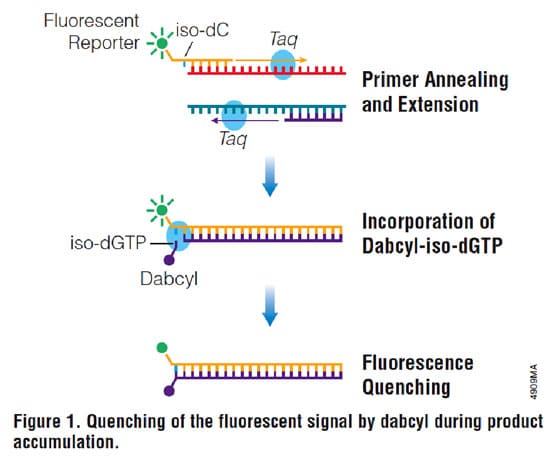PCR has become the tool of choice for molecular diagnostics and is now a staple platform in any laboratory setting. The versatility of this method has led to a myriad of spin-off techniques, including probe-based quantitative PCR (qPCR). This method effectively combines PCR amplification and detection into a single step to measure the specific amount of DNA in a sample. By relying on fluorescent dyes or fluorophore-tagged probes to measure the amount of amplified product, it eliminates the need for gel electrophoresis. Instead, real-time PCR instruments can measure the fluorescence signal during the reaction, allowing fast and accurate quantification of PCR products. To increase the utility of this method, multiplexed qPCR uses several pairs of gene-specific primers and probes to amplify and measure multiple target sequences simultaneously. In this article, I’ll discuss the benefits of this multiplexed approach as well as examine the factors that influence the experimental setup.
Benefits of multiplexing qPCR
Multiplexing may require more time to implement in the lab than the same assays run separately, but undoubtedly the benefits justify the investment. Here are some of the benefits of multiplexed qPCR:
- Efficiency: Multiplexed qPCR helps conserve sample material and avoid well-to-well variation by combining several PCR assays into a single reaction. Multiplexing makes more efficient use of precious samples, such as those harboring a rare target that cannot be split into multiple wells without compromising the sensitivity.
- Economy: Even though the targets are amplified in unison, each one is detected independently by using a gene-specific probe with a unique reporter dye to distinguish the amplifications based on their fluorescent signal. Once optimized and run routinely, a multiplexed assay is more cost effective than the same assays amplified independently.
Experimental setup for multiplexed qPCR
The experimental design for multiplexing is substantially more complex than for single reaction qPCR. Amplification of multiple targets in a single sample can be influenced by many factors, including gene expression levels, primer interactions and competition for reaction reagents. Here are some parameters you need to consider in setting up your assay: Optimize probe and primer design Correct primer and probe design are essential to obtain a balanced amplification for all reactions, to ensure that one assay doesn’t become dominant over the rest. The trick to overcome this challenge is to design assays with uniformly high amplification efficiencies. Additionally, avoid primer sequences that cross-hybridize both within and between assays, which may potentially trigger primer-dimer amplification. Match fluorophores to your instrument optics In multiplexed qPCR signal crosstalk between different fluorescence reporters can compromise quantification or cause false positives. It is therefore essential to select dyes with minimal spectral overlap. The dyes should also be chosen carefully according to instrument optic specifications. Consider the excitation source as well as the band-pass specifications for each filter-set. Optimize multiplex reactions The main factor to ensure optimal multiplex reactions is to choose the most appropriate master mix formulation. For example, if any reaction component is limiting, it may lead to a loss of PCR products, especially for the least abundant targets. Not all master mixes perform satisfactorily and it is prudent to select one specifically formulated for multiplexing. If preparing your own “home-brew” – particularly if used previously for singleplex reactions – the mix should be supplemented with additional Taq polymerase, dNTPs, and MgCl2 to improve its functionality in a multiplexed setup. Verify assay performance For a given DNA amount, each assay combined into the multiplex should produce the same cycle threshold as when amplified individually. When one or more targets are at a high concentration then there is the possibility that other assays in the sample will be negatively impacted such as drop-out at lower dilutions. Any delay in the amplification kinetics will compromise quantification or cause a loss of sensitivity, and can be corrected through the optimization steps mentioned above.
Potential applications
Exploiting the full potential of multiplexed probe-based PCR methods involves maximizing the number of regions that can be amplified simultaneously, saving time and money. Due to its high flexibility, this technique has been successfully applied in many areas, from linkage studies to gene deletion and mutation analysis. From a medical point of view, for example, this approach is particularly useful to study genetic diseases associated with new or previously unknown mutations. Applications may include (1-9):
- Analysis of gene expression levels
- Analysis of satellite DNA
- Analysis of gene deletions
- RNA detection
- Amplification of SNPs
- Mutation and polymorphism analysis
- Estimation of telomere length
- Identification of virus, bacteria, fungi and parasites
- Forensic studies
- Lineage analysis
- Assess food quality and hygiene standards
- Wildlife studies
- Analysis of ancient DNA
- Large scale population screening
- Multiplex PCR: Optimization and Application in Diagnostic Virology. Clin Microbiol Rev. 2000 13(4): 559–570.
- Deletion screening of the Duchenne muscular dystrophy locus via multiplex DNA amplification. Nucleic Acids Res. 1988 Dec 9;16(23):11141-56.
- Evaluation of Digital PCR for Absolute RNA Quantification. PLoS One. 2013; 8(9): e75296.
- Developmental validation of a multiplex qPCR assay for assessing the quantity and quality of nuclear DNA in forensic samples. Forensic Sci Int. 2007 Jul 20;170(1):35-45.
- Development of a multiplex real-time PCR to quantify aflatoxin, ochratoxin A and patulin producing molds in foods. Int J Food Microbiol. 2012 Apr 2;155(1-2):10-8.
- Empirical evaluation of humpback whale telomere length estimates; quality control and factors causing variability in the singleplex and multiplex qPCR methods. BMC Genet. 2012; 13: 77.
- Analytical performance of a multiplex Real-Time PCR assay using TaqMan probes for quantification of Trypanosoma cruzi satellite DNA in blood samples. PLoS Negl Trop Dis. 2013;7(1):e2000.
- Multiplex PCR with minisequencing as an effective high-throughput SNP typing method for formalin-fixed tissue. Electrophoresis. 2007 Jul;28(14):2361-7.
- A multiplex qPCR gene dosage assay for rapid genotyping and large-scale population screening for deletional ?-thalassemia. J Mol Diagn. 2013 Sep;15(5):642-51







